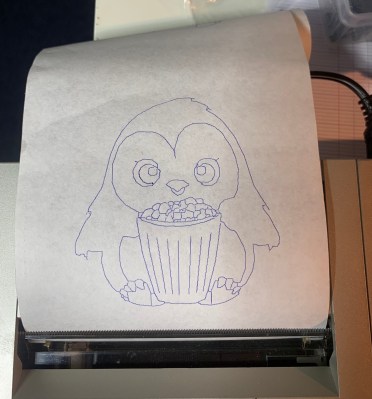[Fred] has a Casio PB-700 pocket calculator / computer, complete with the companion docking station featuring a four-color pen plotter, model FA-10, and a microcassette tape recorder, model CM-1. He really wanted to see what this plotter could do, but there were no demos that he could find. So despite only having one working pen, [Fred] took matters into his own hands and proceeded to make his own.
What if I made a program where I type what I want to draw and the PB-700 just draws it?

[Fred] succeeds, shoehorning several sub-projects into a single convoluted work flow: request an image from the PB-700 and after a long pause the plot emerges. The cute microcassette recorder is too much of a hassle, so he emulates the audio interface on a PC using a utility called casutil that reads and writes .wav files in PB-700 format. Much of his effort is spent figuring out how to request an image from Midjourney without being banned, but eventually comes up with a workable but shaky solution. The last steps are to convert the image into a line drawing, and then wrap up all those X-Y coordinates into a Basic program and send it back down to the PB-700 for plotting.
You can read more details in the PloTTY GitHub repository. There were several of these pocket computers with plotters coming out of Japan in the 1980s. In addition to this Casio, the Radio Shack TRS-80 PC-1 and PC-2 come to mind, which were re-branded versions of the Sharp PC-1211 and PC-1500 models. We wrote about them last year. This author had a PC-2 in 1985 and used it to plot antenna patterns at his desk, bypassing the IT department’s red tape. Have you ever used any of these pocket plotters? If so, let us know in the comments below. Thanks to [Altomare] for send us the tip.















I had a play with a similar mechanism here:
https://youtu.be/gj6BrnpXvRs
It’s not actually the same mechanism, it’s a bit larger.
there is also a typewriter that uses a similar mechanism to write characters:
https://youtu.be/KdLJjT8waBY
but again, that is a different mechanism, and although it is very similar it uses a larger pen.
I wonder if it’s the same mechanism as the 4 color plotter for the TI-99/4A?
Alps mechanics used in Ti HX-1000 is also used in Commodore 1520, Tandy CGP-115, Sharp CE-150, Atari 1020, and Mattel Aquarius 4615. Casio isn’t listed so probably not the same but similar design.
Here is my similarly-sized Sharp PC-1500A + CE-150 plotting out a simple graphic
https://youtube.com/watch?v=o4WztDOztEI
Plus a repair/teardown gallery https://imgur.com/gallery/yuI0Tfr
The CE-150 is a 57mm plotter, the CM-1 (the Casio I used for plotty), is 114mm (I suspect the one from Amenjet is the same wifth).
I bought a PB700 for use in college in early 1987. Wasn’t easy to find in Brazil, it took a bus trip to Paraguay to get mine, to smuggle it in, with Spanish manuals. I used it a lot for classes, especially for fluid mechanics iterative formulas and a Mohr’s circle graphic output. Would have loved to have a plotter. At the time, I spent more time learning programming than understanding the underlying physics of what I was modeling. I loved the “BEEP” functionality and the 10 program partitioning, within 4KB RAM. The PB700 was much better, in my opinion, than the more popular fx702p, due to its larger screen size.
A while back, a friend sent my way a plotter / audio interface for the granddaddy of Casio programmables, the fx602. Haven’t used it yet.
My real workhorse, though, was an HP15c. In 1992, sold them off (HP & Casio) to finance a backpacking trip. 30 years later, I got my *very same* HP15c back from a dear friend (thanks again, JP!). Two battery changes in 30+ years, he said.
Hey, thanks for the writeup. The post isn’t fully finished, there is a video coming and a description of the tracing algo, Any question, just ask me!
Is the BASIC program just a simple loop with a big array of line segment coordinates?
The BASIC program is a set of drawing orders generated by a python script based on the output of midjourney: you enter your prompt on the pb-700, it is sent to the linux box, is sent to discord, the image is received back, a python script traces it, and another python script generates a set of BASIC programs that are sent back to the PB-700 for drawing.
There is an excerpt of the BASIC program in the blog post: http://www.stark.fr/blog/plotty/#generating-the-basic-program
The devil is in the details, see the blog post :-)